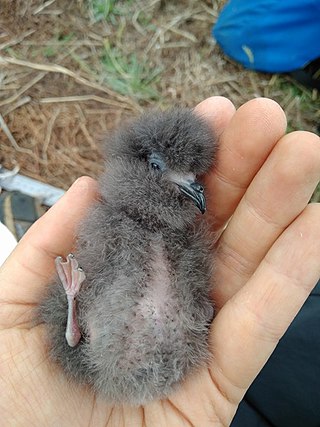
Leach's storm petrel or Leach's petrel is a small seabird of the tubenose order. It is named after the British zoologist William Elford Leach. The scientific name is derived from Ancient Greek. Hydrobates is from hydōr "water", and batēs "walker", and leucorhous is from leukos, "white" and orrhos, "rump". It was formerly defined in the genus Oceanodroma before that genus was synonymized with Hydrobates.

Swinhoe's storm petrel or Swinhoe's petrel is a small, all-brown seabird of the storm petrel family Hydrobatidae.

The band-rumped storm petrel, Madeiran storm petrel, or Harcourt's storm petrel is of the storm petrel family Hydrobatidae.

The ashy storm petrel is a small, scarce seabird of the storm petrel family Hydrobatidae. It breeds colonially on islands off the coasts of California and Mexico, and is one of six species of storm petrel that live and feed in the rich California Current system.

The Ogasawara subtropical moist forests is a terrestrial ecoregion which encompasses the Ogasawara Archipelago of Japan. The Ogasawara Archipelago lies in the Pacific Ocean south of Honshu, Japan's largest island, and north of the Marianas Islands. The ecoregion includes the Bonin Islands and Volcano Islands chains. The islands are volcanic in origin, and have never been linked to a continent. They are home to distinct plants and animals including many endemic species.

The guanay cormorant or guanay shag is a member of the cormorant family found on the Pacific coast of Peru and northern Chile. After breeding it spreads south to southern parts of Chile and north to Ecuador, and has also been recorded as far north as Panama and Colombia – probably a result of mass dispersal due to food shortage in El Niño years. Its major habitats include shallow seawater and rocky shores.

The ringed storm petrel, also known as Hornby's storm petrel, is a seabird that ranges in the Humboldt Current off the coasts of South America. The species is a very distinctive member of the storm petrel family, with a dark cap, white face and underparts, forked tail and a black band across the chest. It is relatively common in the seas off Peru, Chile and Ecuador. The species is named after Admiral Sir Phipps Hornby.

The black storm petrel is a small seabird of the storm petrel family Hydrobatidae. It is 23 cm in length, with a wingspan of 46–51 cm.

The least storm petrel is a small seabird of the storm petrel family Hydrobatidae. It is 13–15 cm in length, with a wingspan of 32 cm. It is the smallest member of the order Procellariiformes. It was formerly defined in the genus Oceanodroma before that genus was synonymized with Hydrobates.

The fork-tailed storm petrel is a small seabird of the storm petrel family Hydrobatidae. It is the second-most abundant and widespread storm petrel and is the only bird in its family that is bluish-grey in colour.

The wedge-rumped storm petrel is a storm petrel. It breeds in the Galápagos Islands and on the coast of Peru. It was formerly defined in the genus Oceanodroma before that genus was synonymized with Hydrobates.

Victorin's warbler or Victorin's scrub warbler, is a species of African warbler, formerly placed in the family Sylviidae. It was recently split from the genus Bradypterus and now belongs to a monotypic genus Cryptillas.

Markham's storm petrel is a species of storm petrel in the family Hydrobatidae. An all-black to sooty brown seabird, Markham's storm petrel is difficult to differentiate from the black petrel Procellaria parkinsoni in life, and was once described as conspecific with, or biologically identical to, Tristram's storm petrel Hydrobates tristrami. Markham's storm petrel inhabits open seas in the Pacific Ocean around Peru, Chile, and Ecuador, but only nests in northern Chile and Peru, with ninety-five percent of all known breeding populations in 2019 found in the Atacama Desert. First described by British ornithologist Osbert Salvin in 1883, the bird was named in honor of Albert Hastings Markham, a naval officer who collected a specimen off Peru.

Tristram's storm petrel or ʻakihikeʻehiʻale is a species of seabird in the storm petrel family Hydrobatidae. The species' common and scientific name is derived from the English clergyman Henry Baker Tristram; the species can also be known as the sooty storm petrel. Tristram's storm petrel has a distribution across the north Pacific Ocean, predominantly in tropical seas.

Ansorge's greenbul or Ansorge's bulbul, is a species of the bulbul family of passerine birds. It is found in western and central Africa. Its natural habitat is subtropical or tropical moist lowland forests.

Monteiro's storm petrel is a seabird species from the storm petrel family, Hydrobatidae. The cryptic species was once considered to be conspecific with the band-rumped storm petrel. The species is endemic to the Azores.

Townsend's storm petrel is a species of seabird in the family Hydrobatidae. It breeds in the summer on rocks and islets of Guadalupe Island off the western coast of Mexico. It ranges in the Eastern Pacific Ocean north to southern California in the United States and south to 10°N latitude. It used to be considered a subspecies of the Leach's storm petrel. It was formerly defined in the genus Oceanodroma before that genus was synonymized with Hydrobates.

Ainley's storm petrel is a species of seabird in the family Hydrobatidae. It breeds in the winter on Guadalupe Island off the western coast of Mexico. It ranges south to the Galápagos Islands. It is considered by some authorities to be a subspecies of Leach's storm petrel.



















